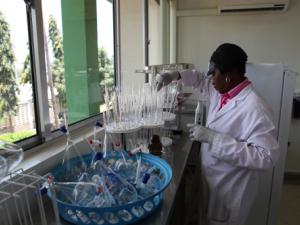Now more than ever Africa needs a steady supply of quality medicine. Not only does the continent bear the burden of 75 percent of the world’s HIV cases and 90 percent of deaths from malaria – it is also facing the spread of non-communicable diseases.
By 2030 the World Health Organisation predicts mortality in Africa from so-called ‘lifestyle diseases’, such as cancer, heart disease and diabetes will exceed the combined deaths from communicable and nutritional diseases.
And yet, as Jürgen Reinhardt from the United Nations Industrial Development Organization (UNIDO) points out, “70 to 100 per cent of medicines needed are actually imported into countries from outside the continent”.
“That is still being looked at as a large dependency on remote sources that people did not and do not want to put up with ad infinitum.”
So in 2007, the 54 members of the African Union endorsed the Pharmaceutical Manufacturing Plan for Africa (PMPA), a non-binding framework “to pursue, with the support of our partners, the local production of generic medicines on the continent...”
The perceived benefits of local production, according to the Plan, include:
- Saving on foreign exchange
- Creating jobs and alleviating poverty
- Promoting intra-African trade
- Fostering new skills and technologies
- Stimulating exports, and
- Enhancing self-sufficiency in drug supply
Dr Skhumbuzo Ngozwana, a consultant and former Chairman of the National Association of Pharmaceutical Manufacturers of South Africa, says local production would help countries respond to demand urgently, without being forced to pay a premium for emergency supplies.
In this video Dr Skhumbuzo Ngozwana explains why security of supply is so crucial to the Pharmaceutical Manufacturing Plan for Africa.
To accelerate the implementation of the PMPA, UNIDO and the African Union Commission jointly produced the 2012 PMPA Business Plan (BP) which identifies a number of obstacles to local production, including:
- Access to finance
- (Small ) size of local markets/ (lack of) economies of scale
- 95% of active pharmaceutical ingredients (APIs) coming from overseas, largely from India and China
- Unavailability of appropriately skilled staff and training institutions
- Knowledge of how to upgrade an existing plant or design a new one
- Weak national/regional pharmaceutical regulation
- Poor implementation of Good Manufacturing Practices/ quality control standards
- Cost of product development, and
- Underdeveloped supporting industries
The current capacity of African countries in pharmaceutical production varies. Some form of pharmaceutical manufacturing takes place in an estimated 38 countries. In Nigeria 200 companies are registered, though in other countries there are none.
It is equally important to distinguish between different levels of production of generic medicines: manufacturing raw materials from basic chemical and biological substances, synthesis of active pharmaceutical ingredients, producing dosages from the active pharmaceutical ingredients, and packaging and labelling finished products.
Laboratory TFDA - access to safe medicines, Tanzania
Local manufacturers face a cost disadvantage because finished medicines can be imported duty free while inputs (such as APIs) carry a duty.
“Active pharmaceutical ingredients account for 60% or more of the final cost of the product,” the PMPA states. “Until primary manufacturing becomes a reality, there will not be meaningful savings of foreign currency. Production equipment, laboratory equipment and reagents etc will be paid for in foreign currency.”
Regarding distribution, Dr Ngozwana worries that foreign companies importing to urban markets in Africa have less incentive to supply rural areas due to the greater cost. Recent research by Professor Maureen Mackintosh at the Open University London shows locally produced products in Tanzania and Ghana are more likely to have a wider reach.
Dr Ngozwana and Mr Reinhardt were in Brussels last month to attend the 5th annual EU-Africa Business Forum and a session on Healthcare and Pharmaceuticals through EU-Africa Business Cooperation, including local production of generic medicines in Africa.
Aside from EU involvement in the implementation of the PMPA Business Plan, Dr Ngozwana believes coordination is possible at other levels.
He suggests highly skilled people in the pharmaceutical industry in developed countries could make their skills available to African countries after they retire. Production equipment that is only three or four years old may be sold, not donated, by leading companies to those now beginning in Africa.
One of the biggest hurdles to the acceptance of locally produced pharmaceuticals in Africa has been the perception that the manufacture of quality medicines is next to impossible. However, Mr Reinhardt says “thankfully, that position has changed”.
“While not being looked at as a panacea, the local production of pharmaceuticals is now being looked as one very doable approach...”
He says drugs produced closer to patients would facilitate regulatory oversight by making verification easier.
“Right now drug procurers have to get the assurance that they are buying quality products by checking out on hundreds, sometimes even thousands of suppliers in faraway places.”
In this context the African Medicines Regulatory Harmonization (AMRH) initiative, launched in unison with the PMPA to build regulatory capacity, is crucial.
“We should remember that there are countries on the continent that do not aspire to pharmaceutical production,” Dr Ngozwana says. “So the plan then caters for those. We talk about training regulators or helping set up regulatory systems in the various countries so that at the very least their ability and the capability to regulate the market and the products on the market is then built in those countries.”
One of the key lessons from previous efforts to foster the pharmaceutical industry in Africa has been the need to act as one.
“In the past what we have tended to have are these vertical, stand-alone solutions that would be implemented in isolation,” Dr Ngozwana says.“Of necessity the impact would be very minimal and in many instances the impact [would be] unsustainable as well.”
This collaborative piece was drafted with input from Juergen Reinhardt and Dr. Christopher Knauth with support from the capacity4dev.eu Coordination Team.






Log in with your EU Login account to post or comment on the platform.